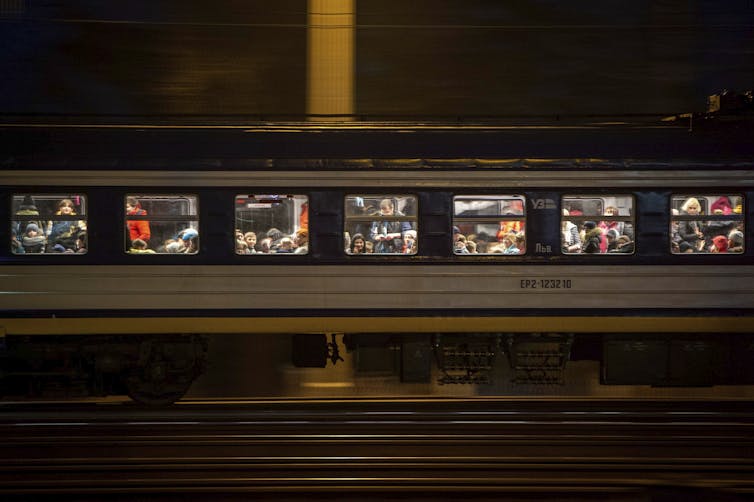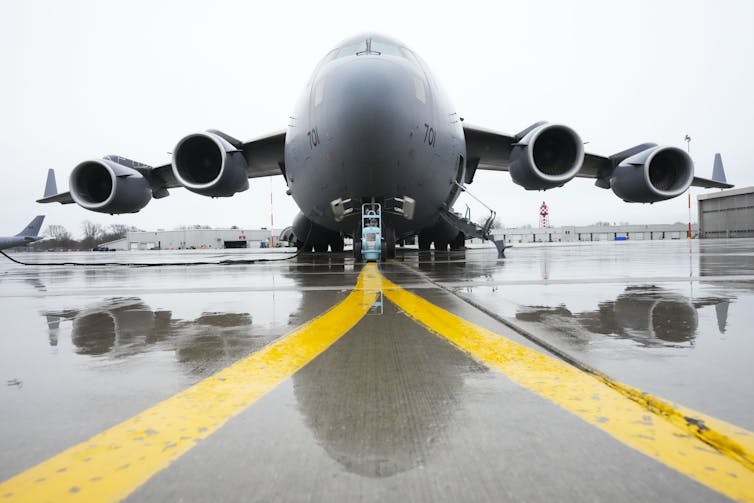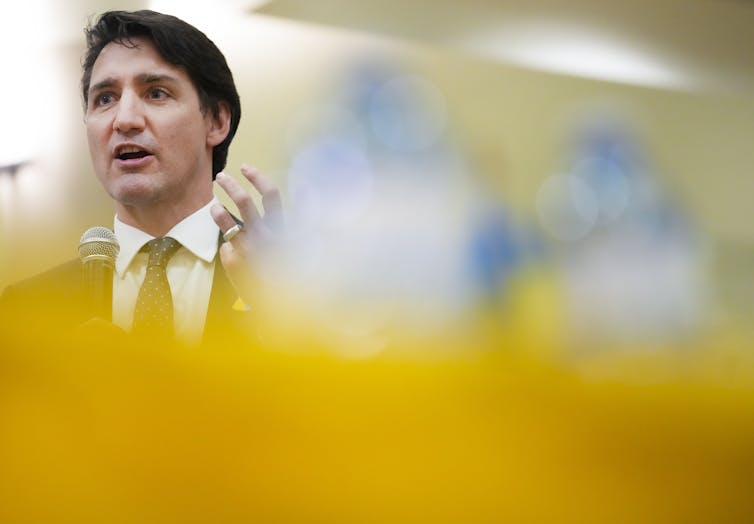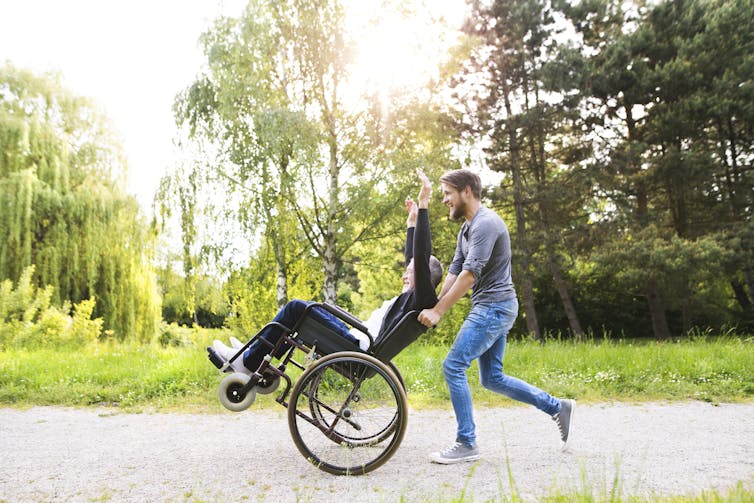
USA & CANADA (901)
Latest News
Is Canada’s welcome to fleeing Ukrainians a new era of refugee policy?
Friday, 11 March 2022 11:17 Written by theconversation 
Adèle Garnier, Université Laval; Jamie Chai Yun Liew, L’Université d’Ottawa/University of Ottawa, and Shauna Labman, University of Winnipeg
In less than two weeks, more than two million people have fled Ukraine following the Russian invasion. Many in the Ukrainian-Canadian community have had to flee before as refugees and Canada now boasts the world’s second-largest Ukrainian diaspora.
Canada is known to be welcoming to refugees — to those from Vietnam in the 1970s, for example, and from Syria and Afghanistan more recently — and is seen as a global refugee resettlement leader. But Canada’s response to Ukrainians fleeing the war is different than past policy.
Special admission provisions
When the invasion on Ukraine escalated on Feb. 24, 2022, Justin Trudeau’s government introduced special admission policies for Ukrainian nationals.
The Canada-Ukraine Authorization for Emergency Travel allows an unlimited number of Ukrainians fleeing the war to apply to stay in Canada for two years. Canada is also prioritizing applications of Ukrainian nationals reuniting with family in Canada, extending visas and permits of Ukrainians already in Canada and offering open study and work permits.
Canadian-Ukrainians and refugee advocates have welcomed the measures yet also raised concerns.
First, emergency travel applicants still need a visa, whereas several countries in Europe have suspended visa requirements for Ukrainians. Canada is ramping up identification procedures, including biometrics, in central European countries receiving Ukrainian refugees, and is waiving fees for travel documents.

Immigration, Refugee and Citizenship Canada (IRCC) has long been plagued by processing delays. The new measures have raised concerns that they might have an impact on other refugees awaiting resettlement to Canada, in particular those from Afghanistan.
Immigration Minister Sean Fraser has stated: “We can do more than one thing at a time,” and says delays in the admission of Afghan refugees is a logistical challenge on the ground rather than a processing problem.
IRCC has, however, pointed to processing delays to justify technology acquisitions and purchases to speed up decision-making on the admission of refugees. Yet the use of artificial intelligence to deal with immigration applications raises issues of discrimination and racism.
Temporary protection
The Canada-Ukraine Authorization for Emergency Travel also differs from Canada’s previous resettlement efforts since it offers only temporary protection.
Similarly, the European Union, for the first time, triggered its Temporary Protection Directive for people fleeing Ukraine, which also only provides temporary protection.
The EU response was designed for “mass influx” scenarios. Protection is offered for one year, with the possibility to extend for two more years. Access to the asylum system in EU countries is still available to those who receive temporary protection.
Canada grants temporary protection for “at least” two years. But there are lingering questions on the durability of the Canadian response for those fleeing Ukraine. What happens once temporary protection measures ends is an open question.
While some may benefit from the new permanent residency pathway through family sponsorship, not all emergency travel applicants have family in Canada.
As we saw for those who fled Hong Kong to Canada by obtaining a visa, this was just the first hurdle to overcome. Canada is offering the same option to those fleeing Ukraine. Obtaining refugee protection or accessing other immigration pathways at a later date, however, is another obstacle with no guarantee of success.
It remains to be seen whether Ukrainians who wish to settle in Canada permanently will be required to apply for asylum, and if many will find other permanent residence pathways such as post-graduate and employer-sponsored visas.

Who’s left out
Both the Canadian and EU responses raise questions about the differential treatment of people on the move. Canada’s response only applies to Ukrainian nationals. The EU’s measure includes third-country nationals fleeing the war as long as they’ve been legally living in Ukraine. Both responses leave undocumented persons without protection.
In 2019, the International Organization for Migration noted up to 60,900 undocumented people were in Ukraine, mostly from South Asia and Africa. The lack of legal protection options and reported instances of racism and discrimination means not everyone is able to access protection.
The movement of people from Ukraine will continue indefinitely. It’s still early days, and Canada’s response will undoubtedly evolve.

But it should be more inclusive, addressing non-Ukrainians fleeing the country as well. Further, temporary protection ensures Ukrainians are brought to safety faster. But will this kind of response become the preferred method in the future for all refugees? Are more permanent solutions forthcoming?
Temporary measures impose a burden on refugees to apply for numerous legal processes with no guarantee of permanent residence. As refugee advocates, we’re weary of providing the limited rights of temporary protection instead of putting in place robust asylum and resettlement programs.![]()
Adèle Garnier, Professeure adjointe, Département de géographie, Université Laval; Jamie Chai Yun Liew, Director of the Institute of Feminist and Gender Studies and Associate Professor, Faculty of Law at the University of Ottawa, L’Université d’Ottawa/University of Ottawa, and Shauna Labman, Associate Professor of Human Rights, Global College, University of Winnipeg
This article is republished from The Conversation under a Creative Commons license. Read the original article.
War: Ukraine to receive anti-tank weapons from Canada amid Russia’s invasion
Tuesday, 01 March 2022 12:09 Written by dailypost.ngCanada will send anti-tank weapons and upgraded ammunition to support Ukraine amid global rage over Russia’s invasion.
Canadian Prime Minister, Justin Trudeau disclosed this at a news conference on Monday.
“Yesterday, we announced that we would be sending new shipments of military supplies, including body armour, helmets, gas masks and night-vision goggles.
“Today, we’re announcing that we will be supplying Ukraine with anti-tank weapons systems and upgraded ammunition,” said Trudeau.
Trudeau added that the Canadian government plans to prohibit all imports of Russian crude oil.
This is in addition to earlier shipments of lethal and non-lethal equipment to Ukraine.
The Canadian government is also carrying out a series of sanctions on Russia, including closing off Canadian airspace to Russian planes and prohibiting Canadian financial institutions from engaging in any transaction with the Russian Central Bank.
Russian war: US offers major support to Ukraine as war enters third day
Saturday, 26 February 2022 09:29 Written by dailypostU.S President, Joe Biden instructed State Department to release up to $350 million in security assistance to Ukraine, according to CNN.
Russian President Vladimir Putin government began invasion of neighbouring Ukraine on Thursday.
Biden instructed Secretary of State, Antony Blinken to release up to $350 million in immediate support to security and defense.
CNN says that this was contained in a new memo released by the White House late Friday.
This is the third drawdown of money; previous orders have been for $60 million and $250 million, putting the total over the last year at over a billion dollars, according to an administration official.
The State Department is expected to issue its own statement with more details shortly.
This release comes after a 40-minute call between Biden and Ukrainian President Volodymyr Zelensky earlier Friday, during which they discussed “concrete defense assistance.”
Family Day imagery neglects family caregivers’ care work; it needs to be valued
Monday, 21 February 2022 14:56 Written by theconversation 
Janet Fast, University of Alberta and Jacquie Eales, University of Alberta
Family Day often evokes images of families enjoying the outdoors together, playing board games or sharing a meal. But these images neglect the hidden care that nearly eight million caregivers across Canada provide.
One in four Canadians aged 15+ provide care to family, friends and neighbours with chronic health problems, physical or mental disabilities or functional limitations.
The ongoing nature of this care work comes with both rewards and penalties. Caring for family and friends helps people give back, feel close and can give people a sense of competence and purpose. At the same time, many caregivers have to deal with their own poor health, strained social connections and out-of-pocket expenses.
These negative outcomes threaten the sustainability of caregivers’ care work and affects their well-being. Family caregiving is often ignored because it is unpaid, undervalued, hidden in the privacy of homes and care facilities and done primarily by women.
As a family economist, and a family caregiving researcher, (and family caregivers ourselves) we know this work isn’t free. Whether it’s personal care, housekeeping, managing appointments and services, or even home-based kidney dialysis, there’s nothing “free” about a family caregiver’s care work. And the COVID-19 pandemic has made that even more obvious.
Outbreaks in long-term care, work-from home mandates, job losses and shortages of formal home care services have complicated and intensified family caregivers’ responsibilities, isolation and stress.
The pandemic has also increased caregivers’ financial burden and reduced their ability to get much-needed outside support.
Despite this care crisis, family caregivers have carried on as best they can. Their collective efforts — 5.7 billion hours of family care work annually — help sustain the public continuing care systems that are increasingly dependent on them and reduce the burden on taxpayers.
$97.1 billion to replace families’ care work
Using data from Statistics Canada’s most recent (2018) national survey on caregiving and care receiving , we found that families play a central role in meeting Canadians’ care needs.
Unpaid family caregivers in Canada spent an extraordinary 5.7 billion hours annually supporting others. It would take 2.8 million full-time paid care workers to do this work instead. Multiply that by the national median hourly wage of $17 for home support workers and you get a staggering $97.1 billion as the estimated cost to replace Canadian families’ care work.
To fully understand the magnitude of caregivers’ contributions to Canadian society, consider that $97.1 billion represents 32.2 per cent of national expenditures on formal health care, and more than three times the national expenditures on continuing care services like home, community and long-term care.
Without the ongoing commitment and labour of family caregivers, the Canadian continuing care sector would collapse.
This $97.1 billion value also represents 4.2 per cent of gross domestic product (GDP). That’s double the contributions of industries such as agriculture, utilities and hospitality, and 67 per cent of the contribution of the health-care and social services sectors combined.
Policymakers rely on GDP as a universal measure of a country’s social and economic performance and standard of living that guides their policy decisions. Yet, because GDP omits the value of unpaid care work, it is an incomplete measure leading to flawed public policy.

Key component of the care economy
Many social injustices arise from the invisibility and devaluation of families’ care work. Caregivers who are women, have lower incomes, are in their peak earning years and contribute more than their share.
Bringing family care into debates about the overall economy and accounting for caregivers’ contributions is sparking conversations about recognizing the care economy as a key component and growth engine for Canadian society. We define the care economy as paid and unpaid care work that supports people who are care-dependent because of their chronic health conditions or disabilities, or because of their young age.
Documenting the enormous volume and monetary value of family members’ care work establishes it as an indispensable social and economic activity. Yet it is often left out of the public policy agenda.
It’s time to complete the picture and recognize public expenditures on supports for family caregivers as social investments in the well-being of individuals, families and communities. It’s time for a National Caregiver Strategy and a Canada that recognizes, respects and supports the integral role of family caregivers in society.
Our study on the value of unpaid family care work is a collaborative project of Janet Fast, Jacquie Eales, Norah Keating and Choong Kim from the University of Alberta and Karen Duncan from the University of Manitoba.![]()
Janet Fast, Professor and Co-Director, Research on Aging, Policies and Practice, University of Alberta and Jacquie Eales, Research Manager, Research on Aging Policies and Practice, University of Alberta
This article is republished from The Conversation under a Creative Commons license. Read the original article.
Popular News
One-third of Canadian seniors who rent or pay a mortgage are struggling to pay their bills
Monday, 21 February 2022 14:53 Written by theconversation 
Alex Bierman, University of Calgary and Yeonjung Lee, University of Calgary
Seniors are being forced out of their homes due to rent increases. They’re having trouble finding new, affordable accommodations. And the rent for senior housing can be more than a pension pays.
Our recent survey shows that these aren’t isolated incidents. Many Canadian seniors who rent or pay a mortgage are having trouble making ends meet.
In September 2021, we worked with the Angus Reid Forum to survey over 4,000 people. We asked people from all across Canada between the ages of 65 and 85 about their recent financial experiences — whether they had trouble paying for bills, necessities and whether their debt had increased.
And our results were consistent and disturbing.
Cutting back
Many seniors are struggling to pay bills. Over a third of older adults who rent or pay a mortgage reported trouble paying bills, while only about 12 per cent of outright homeowners struggled with their bills.
And they’re not just struggling with rent and mortgage. Seniors are also having trouble affording basic necessities, like food. We asked people about eating less than they thought they should because of a lack of money — over one-quarter of renters and almost one-fifth of people paying mortgages reported having eaten less. Meanwhile, less than 10 per cent of Canadian homeowners also reported cutting back on food.
Medical care is another big issue. With Canada’s publicly funded healthcare system, it may seem like seniors shouldn’t have trouble affording medical care. But many still do, and paying for a home is a major risk factor.
We asked people whether they delayed or skipped medical care or prescriptions because of the costs. About 13 per cent of outright-homeowners told us they had. Almost double for those paying a mortgage and it was even worse for people paying rent. About one-third of senior renters had trouble affording medical care or prescriptions.
The finances of seniors who rent or pay a mortgage also got worse during the pandemic. Over 30 per cent reported increased debt in the past year. While only about 12 per cent of outright-homeowners reported greater debts.
Reigning in rent
The financial plight of renters and mortgage-holders is likely to become an even more pressing issue. Larger groups of people are entering their senior years, while more seniors are being burdened by debt than in the past.
Some provinces are trying to address these issues by reigning in rent increases. Provinces like British Columbia, Ontario, Nova Scotia, New Brunswick and Prince Edward Island (PEI) restrict how much landlords can raise rent — these limits are usually between one and two per cent.

But rent control isn’t enough. When finances are stretched so thin, even small increases in housing costs may be a serious threat to financial stability. Rent control also won’t help people who pay a mortgage and mortgage-holders are subject to fluctuations in interest rates that can increase required payments.
Building more housing is also unlikely to be a solution because supply of housing is only one factor in housing prices. Also, landlords still need to take in enough rent to cover the costs of building and operating rental housing — that limits how much rent can decrease, even if new rentals are built.
This is why greater directed subsidies to assist financially vulnerable seniors may be a better solution. Financial supports can contribute to helping older adults avoid having to choose between keeping a roof over their heads or food on the table.
Financial supports
The federal government is taking steps to assist financially vulnerable seniors. Supports for those aged 75 and over are increasing by 10 per cent in July 2022. But this change won’t help those younger than 75.
Although government support for low-income seniors has increased in recent years, it clearly isn’t enough. And financial shortfalls are forcing many seniors to make tough decisions when it comes to being able to afford a home or other needs.
Canadians need to take steps to better address the financial insecurity of seniors. Otherwise, Canada may encounter a growing tide of desperate seniors in the near future.![]()
Alex Bierman, Associate Professor, Department of Sociology, University of Calgary and Yeonjung Lee, Associate Professor, Faculty of Social Work, University of Calgary
This article is republished from The Conversation under a Creative Commons license. Read the original article.
Our battles with prostate cancer
Sunday, 20 February 2022 00:58 Written by thenationonlinengIn a rare instance of coincidence, Taiwo and Kehinde Abiodun, identical twin brothers based in the United States of America and Canada respectively, have both had to battle with prostate cancer. As they clock 60 years today, they seized the opportunity of their birthday in separate interviews to counsel the young and the old on the need to check their prostate specific antigen (PSA) regularly, considering that early detection of the ailment can help to get rid of it.
Going down memory lane, Taiwo, who said they were born to the family of the late Joshua Adepoju Abiodun and his wife, Caroline Oladoyin Abiodun (nee Olakunori), recalled that people could hardly distinguish him from his twin brother as growing up children.
He said: “When we were growing up, people could hardly distinguish us from each other. In fact, our father could not differentiate us.
“Our elder brother, Prof. Rowland, would just call us Twins and whoever was concerned would answer him.
“But as we grew up and got more matured slight differences began to manifest.
“For instance, it became apparent that I could talk a lot more than Kehinde who is a bit more reserved.
Corroborating his twin brother, Kehinde said: “Honestly, it is now that we have different characters; one is more jovial than the other or one is more serious in look than the other. It was only with our voice that our father could determine who was Taiye or Kehinde.”
But beyond their physical appearance, there are many other areas the identical nature of Taiwo and Kehinde come to the fore. These, according to Taiwo, include the schools they attended and even their attitude to life.
He said: “We have the same attitude to life. We also attended the same primary and secondary schools before we parted ways academically. But I must confess that my twin brother (Kehinde) was more brilliant.
“When we were at the All Saints’ Modern School, Owo (Ondo State), I would come first in my class while he would come third in his; but his aggregate score was always higher than mine.
“We were only separated when we gained admission to higher institutions and were further separated when Kehinde joined his family in Canada 22 years ago.
“The last time we saw was 15 years ago when he came home to attend our mother’s funeral. But thanks to technology, we speak daily and do video calls.
“In spite of our identical nature, civilization separated us. Imagine he lives in Canada and he and his children are now Canadian citizens while I live in America and by marriage to my wife Ronnie, who is an African-American, sooner or later, I would become one of them.
“Imagine a set of identical twins belonging to different nationalities, thanks to naturalization.
Yet by far the most shocking of the things they shared together is that they were both diagnosed with the same life-threatening disease, namely prostate cancer, and they are both living with it!
Taiwo said: “We share many things in common, like he was operated on for prostate cancer about 10 years ago while I also had my own operation for prostate cancer about two years ago. We are both living with prostate Cancer and have become advocates against the disease, educating men about it.
Kehinde recalled that he was shocked to the marrow when he was diagnosed with prostate cancer about 11 years ago. But he said his shock did not emanate from fear that he could die.
“No, I was not afraid and I am not afraid of death,” he said in response to a question
“I was only shocked at the thought of what would be happening to the men in Nigeria since I was diagnosed prostate cancer here in my base here in Canada. How would they know that they have prostate cancer? Can they afford this?
“When you hear cancer, your heart would jump into your mouth. So I went straight to one of my brothers, Prof. Rowland Abiodun, in Massachusetts, USA. He calmed me down and prayed for me, and I went for the surgery which was successful.”
Since then, he has gone into advocacy against the disease, educating people on how to avoid it.
“Last year, I organised a session for two organisations here in Canada and in America. The major fears about prostate cancer are death and erectile dysfunction.
“Early detection helps, and there is treatment for erectile dysfunction if it happens after surgery. Therefore, there is no cause for fear at all.
“I regained my erection nine or ten months after the surgery. It is not a shameful thing. Women are also prone to breast cancer, uterus cancer, ovarian cancer, and so on, and early detection helps.”
Taiwo on his part said it was his wife that God used to detect his prostate cancer before it could get too bad.
He said: “God used Ronnie, my wife, to save my life because she suspected that something was wrong with me. She took me to the doctor who discovered that I had prostate enlargement and cancer and I went through surgery in 2019. She calmed me down and since then I have been living with it.
“My PSA was high and the doctor was afraid. But later I was operated on and the rest is now history.”
He added: “Ronnie is one of the most responsible women I have ever met. Although we have cultural differences, she quickly understood me. She loves my dressing some Nigerian ladies would object to.
“I have met some ladies in Nigeria who condemned my dressing, saying my bling bling is juju despite my spirited effort to explain to them that it is my own style of dressing.
“My bling bling is my trade mark. It is my logo, so why should I allow a lady to deny me what I love doing?”
credit link: https://thenationonlineng.net/our-battles-with-prostate-cancer/
Nigerian-born doctor named one of 50 most influential Canadians
Friday, 18 February 2022 18:30 Written by ThenewsNigerian-born, Brampton-raised physician Chika Stacy Oriuwa has been named as one of Canada’s 50 most influential people.
Oriuwa, the daughter of Nigerian immigrants who grew up in Brampton, Canada came in 37th on the Macleans Power List, which is a ranking of the 50 influential Canadians.
No mean feat? Certainly. Oriuwa’s achievement is not coming as a surprise. She is a serial achiever. She is not just a psychiatry resident at the University of Toronto, she graduated in 2020 and was the sole valedictorian of her class. She was also the only Black woman to receive the honour in the school’s 179-year history according to the Power List.
Oriuwa is also an accomplished spoken-word artist who has competed nationally as a slam poet, and a video of her 2017 poem Woman, Black has been viewed more than 12,000 times on YouTube.
Oriuwa has also been an inspiration to black women in Canada. She said she spoke at her old high school in Brampton and had a young Black woman tell her that she wanted to be a doctor “because you did it, and you’re just like us’.”
“To be able to inspire them is so incredible for me,” Oriuwa said.
In August 2021, toymaker Mattel selected Oriuwa for its Barbie Role Models program as one of six women working on the frontlines of the COVID-19 pandemic to be immortalised as a Barbie doll.
“It was such a full-circle moment for me, as a young girl who played with Barbies and always really wanted to see myself reflected,” Oriuwa said in an interview. “Not only as a child who wanted to be a physician but as a young Black girl.”
The psychiatry resident, whose parents emigrated to Canada in the 1980s, says she chose the field because it has “some of the most marginalised patient demographics in medicine.”
In 2017, the University of Toronto created the Black Student Application Program (BSAP), an optional application process that requires the same standards and includes an interview process conducted by members of the Black community, faculty, and students, and Oriuwa became an ambassador and public face of the program.
In medical school, Oriuwa co-founded the Black Interprofessional Students’ Association (BIPSA) to network students across graduate programs. She also served as a strategic advisor and contributing writer to Healthy Debate, a healthcare journalism platform.
In 2018, she delivered the keynote speech at Women’s College Hospital for International Women’s Day, entitled “Thriving at the Intersections: Being a Black Woman in Medicine.” She was a speaker at the 2018 International Women and Children’s Health Conference at McMaster University. In 2019, she was a workshop speaker at the Canadian Conference on Physician Leadership.
She has said she uses poetry both as an outlet for her struggles with encountering racism and as a form of advocacy against it, and during her second year of medical school, created a spoken word video titled, “Woman, Black.
Some of the awards and honours she has received include: the 2018 African Scholars Emerging Academic Award – University of Toronto, 2020 Valedictorian of the University of Toronto Faculty of Medicine and 2021 Barbie Role Model Program honoree.
Russia to employ actors and create fake graphic video to justify Ukraine invasion - US alleges
Sunday, 06 February 2022 16:31 Written by lindaikejiblogThe US has alleged that Russia is preparing to "fabricate a pretext for an invasion" of Ukraine, using a "graphic" video that would depict a fake attack carried out by Ukraine against Russia.
According to the CIA, the US has intelligence suggesting that the Russian government, with the help of Russia's intelligence services, has been planning to produce a propaganda video depicting graphic scenes of a "staged false explosion with corpses, actors depicting mourners, and images of destroyed locations and military equipment," the official said.
The US says it believes Russia has already recruited actors to be involved in the video production of the alleged fake attack. It also alleged that the military equipment used in the video of the fabricated attack would be made to look like it is Ukrainian or from a nation allied to Ukraine.
The US said the video could include images of Bayraktar drones, which NATO ally Turkey has provided to Ukraine, "as a means to implicate NATO in the attack."
The fake attack in the video would be aimed against Russian sovereign territory or against Russian-speaking people, US officials said, and would "be released to underscore a threat to Russia's security and to underpin military operations," the official said.
"This video, if released, could provide Putin the spark he needs to initiate and justify military operations against Ukraine."'
"It shows the level of cynicism, frankly, that is on the other side of this conflict," Deputy national security adviser Jon Finer told MSNBC on Thursday, February 3.
"We're not saying definitively this is what they're going to do. We are saying that this is an option under consideration, and that they have used these sorts of pretext in the past to justify military action."
Finer said the US is making the accusation public in order to "make it much more difficult for [Russia] after the fact to claim that they had to do whatever they decided to do."
This comes as Russia continues building up forces and military equipment along Ukraine's borders, despite diplomatic efforts by the US and allies to de-escalate the situation.
In January, the US revealed it had information indicating Russia had prepositioned a group of operatives to conduct a false-flag operation in eastern Ukraine in an attempt to create a pretext for an invasion.





